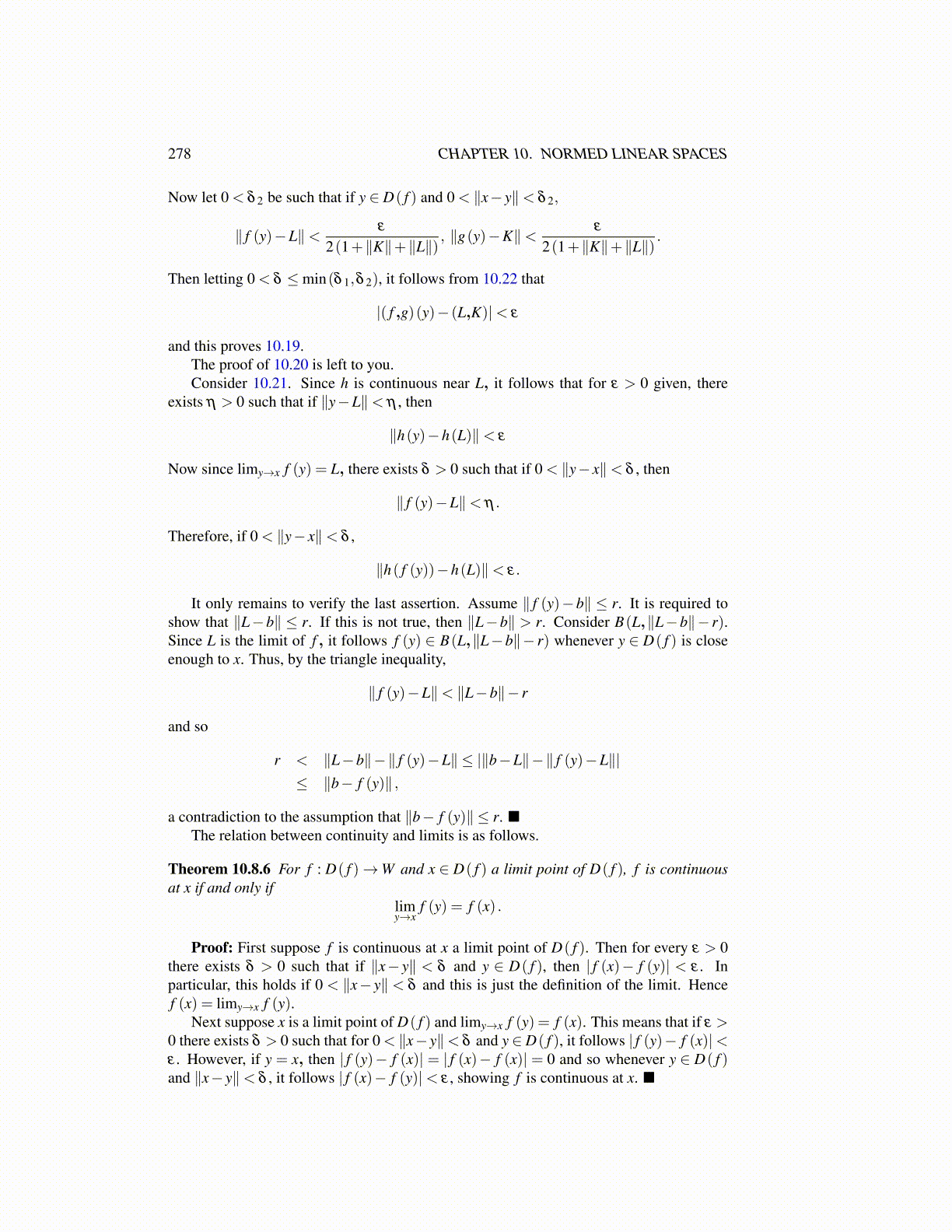
278 CHAPTER 10. NORMED LINEAR SPACES
Now let 0 < δ 2 be such that if y ∈ D( f ) and 0 < ∥x− y∥< δ 2,
∥ f (y)−L∥< ε
2(1+∥K∥+∥L∥), ∥g(y)−K∥< ε
2(1+∥K∥+∥L∥).
Then letting 0 < δ ≤min(δ 1,δ 2), it follows from 10.22 that
|( f ,g)(y)− (L,K)|< ε
and this proves 10.19.The proof of 10.20 is left to you.Consider 10.21. Since h is continuous near L, it follows that for ε > 0 given, there
exists η > 0 such that if ∥y−L∥< η , then
∥h(y)−h(L)∥< ε
Now since limy→x f (y) = L, there exists δ > 0 such that if 0 < ∥y− x∥< δ , then
∥ f (y)−L∥< η .
Therefore, if 0 < ∥y− x∥< δ ,
∥h( f (y))−h(L)∥< ε.
It only remains to verify the last assertion. Assume ∥ f (y)−b∥ ≤ r. It is required toshow that ∥L−b∥ ≤ r. If this is not true, then ∥L−b∥ > r. Consider B(L,∥L−b∥− r).Since L is the limit of f , it follows f (y) ∈ B(L,∥L−b∥− r) whenever y ∈ D( f ) is closeenough to x. Thus, by the triangle inequality,
∥ f (y)−L∥< ∥L−b∥− r
and so
r < ∥L−b∥−∥ f (y)−L∥ ≤ |∥b−L∥−∥ f (y)−L∥|≤ ∥b− f (y)∥ ,
a contradiction to the assumption that ∥b− f (y)∥ ≤ r. ■The relation between continuity and limits is as follows.
Theorem 10.8.6 For f : D( f )→W and x ∈ D( f ) a limit point of D( f ), f is continuousat x if and only if
limy→x
f (y) = f (x) .
Proof: First suppose f is continuous at x a limit point of D( f ). Then for every ε > 0there exists δ > 0 such that if ∥x− y∥ < δ and y ∈ D( f ), then | f (x)− f (y)| < ε . Inparticular, this holds if 0 < ∥x− y∥ < δ and this is just the definition of the limit. Hencef (x) = limy→x f (y).
Next suppose x is a limit point of D( f ) and limy→x f (y) = f (x). This means that if ε >0 there exists δ > 0 such that for 0 < ∥x− y∥< δ and y ∈D( f ), it follows | f (y)− f (x)|<ε . However, if y = x, then | f (y)− f (x)| = | f (x)− f (x)| = 0 and so whenever y ∈ D( f )and ∥x− y∥< δ , it follows | f (x)− f (y)|< ε , showing f is continuous at x. ■